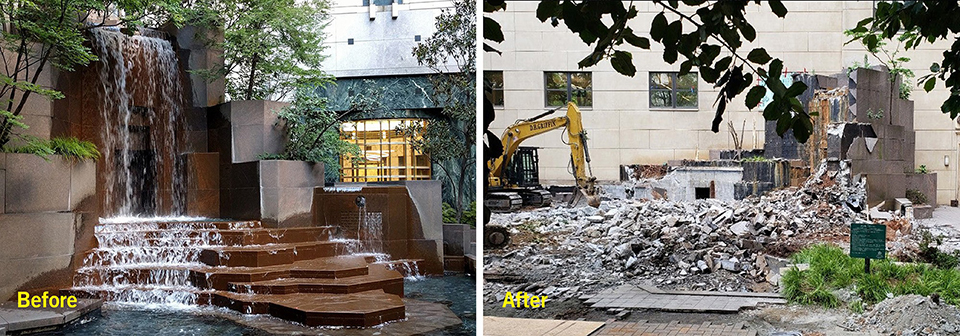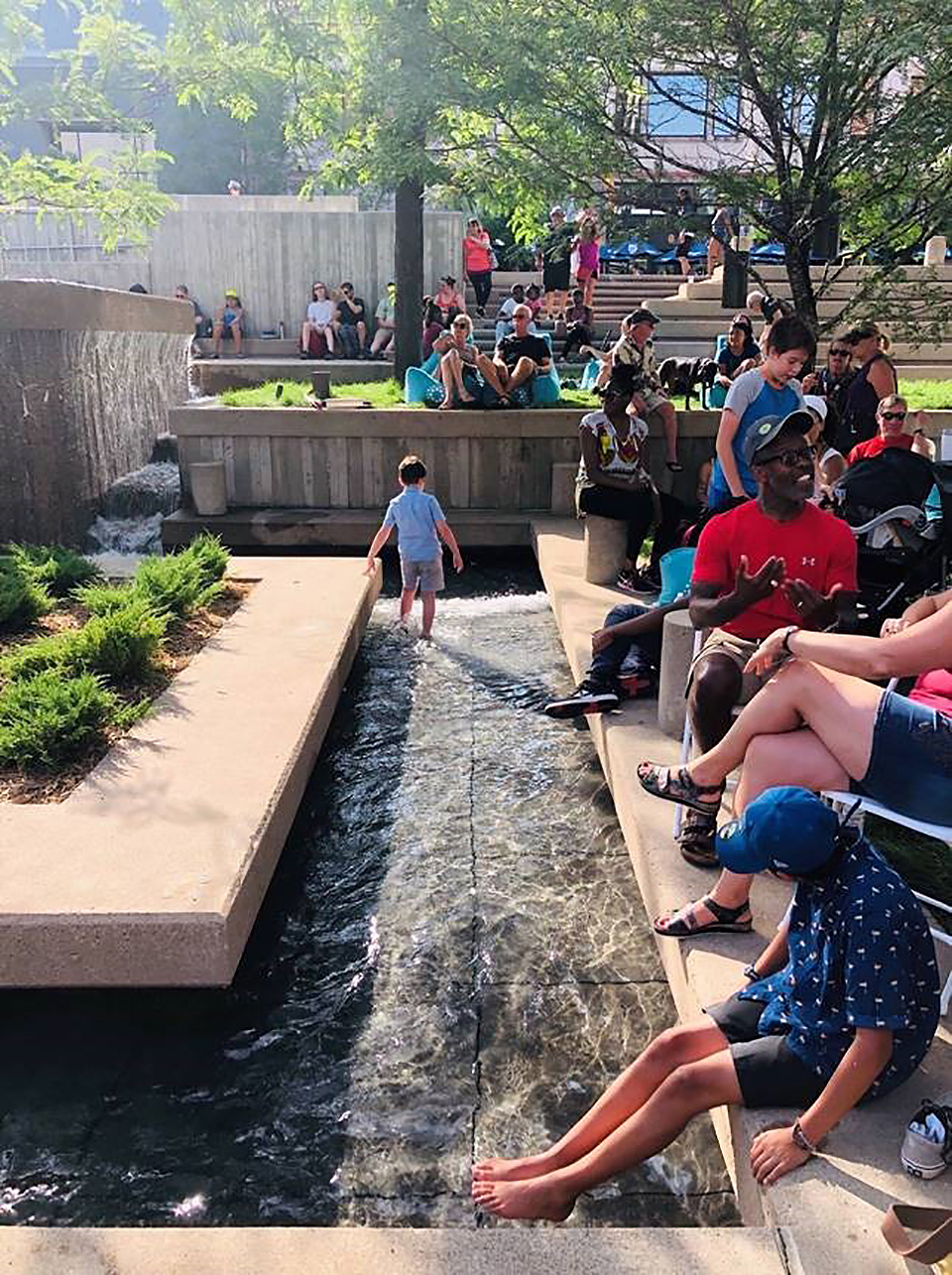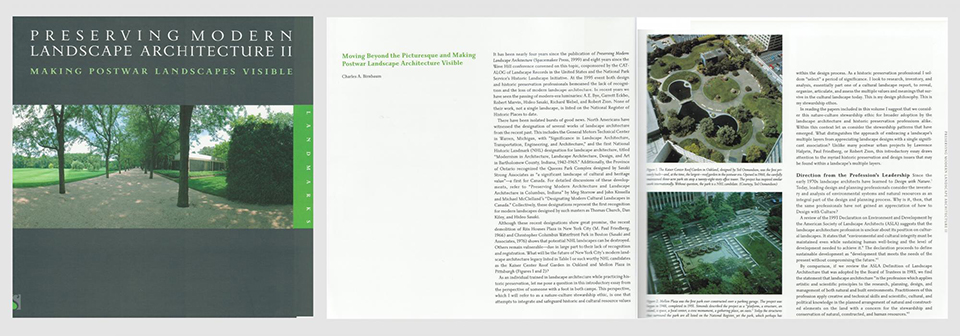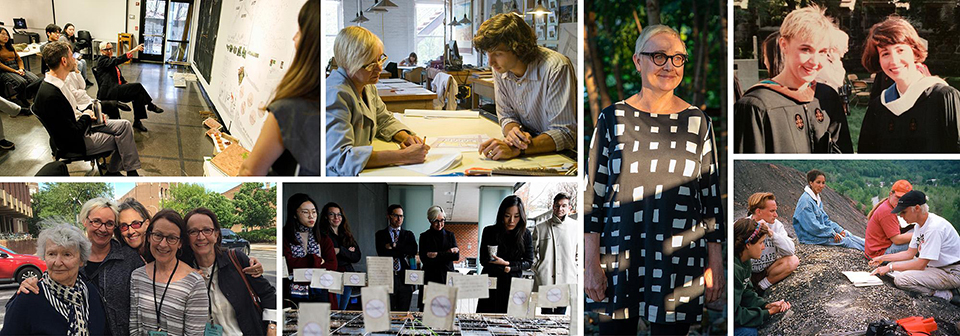Introduction Overview
Words matter … and they can lead to actions that yield results.
About twenty years ago, the landscape architect Lawrence Halprin recounted for The Cultural Landscape Foundation’s (TCLF) President and CEO Charles A. Birnbaum insightful remarks made by landscape architect A.E. Bye in 1995. Bye observed, “we spend thirty or forty years trying to get our projects built and then the next ten to twenty years trying to make sure they don’t get knocked down.” To this we might add that it may then take ten to twenty years of advocacy to rescue, revitalize, and rehabilitate a site.
The backdrop for Halprin and Birnbaum’s conversation was the loss, without any public discourse or debate, of significant works of landscape architecture (particularly Modernist works). That conversation sparked the creation of TCLF’s Landslide program, which is now the cornerstone of the foundation’s advocacy efforts.
 Polk Park, Charlotte, NC, designed by Angela Danadjieva, was featured in Landslide 2020: Women Take the Lead. It was demolished in May 2023.
Polk Park, Charlotte, NC, designed by Angela Danadjieva, was featured in Landslide 2020: Women Take the Lead. It was demolished in May 2023.
To date, as a result of TCLF’s annual thematic Landslide reports and exhibitions about threatened landscapes, and a diversity of public engagement strategies, more than 60 landscapes have been saved while another 150 remain “at risk.”
On the occasion of TCLF’s 25th anniversary, this Landslide report is both a retrospective look at threatened cultural landscapes that have been saved, and a moment to look forward to new opportunities, challenges, and possibilities as TCLF broadens its lens, expands its research, and leverages the public’s expanded interest and understanding in cultural landscapes.
Landslide 2023: 25 Years/25 Saved provides an overview of advocacy and advocates, often working together in strategic partnerships (there really is power in numbers), who have helped set the agenda, build public awareness and engagement, empower stewards, get a seat at the table, secure media coverage, and lead the effort to sympathetically manage change at culturally significant sites.
Advocacy has been at TCLF’s core since its founding. We consistently advocate the need to “make visible, instill value, and engage.” And, because change is inevitable, especially with landscapes, this advocacy is focused on “managing change.” We recognize that different landscapes have different “carrying capacities” for change depending on their integrity and significance. When it comes to important landscapes, the idea is to do no harm during rehabilitation efforts, which was the case at Minneapolis’ Peavey Plaza, Park Central Square in Springfield, MO, and the Quarry Amphitheatre at the University of Southern California in Santa Cruz. This report’s 25 individual sites and site groupings feature some 40 landscapes, ranging in size from Russell Page’s intimate viewing garden at the Frick Collection in New York City to the vast expanses of the Bears Ears National Monument in Utah. The idea of managing change has been critical at each.
 Peavey Plaza, Minneapolis, MN, after rehabilitation, 2019. Photo courtesy Fluidity Design.
Peavey Plaza, Minneapolis, MN, after rehabilitation, 2019. Photo courtesy Fluidity Design.
Advocacy, as this Landslide report reveals, is important to recognizing the historic significance and value of a site, increasing the base of stakeholders, improving stewardship commitments, increasing park and open space equity, revealing cultural lifeways, avoiding and reversing the erasure of sites, and amplifying community voices.
When TCLF was founded in 1998, it was conceived as a non-membership organization with all its resources available for free online; the world wide web was still emerging (for context, Facebook wouldn’t start for another six years). Today we have a constellation of social media sites and extraordinary access to information, along with text alerts, TikTok, Instagram, YouTube, and so much more. All are avenues for advocacy, and we leverage them heavily; presently, TCLF’s bi-weekly e-newsletters reach more than 31,000 recipients.
One of the most important parts of TCLF’s advocacy is partnerships with international, national, regional, and local organizations. For example, the Los Angeles Conservancy, Docomomo, National Trust for Historic Preservation, and others each bring a knowledge and depth of understanding about a given site, a local ordinance, or a statewide law, and they bring to the table resources that need to be marshalled in an advocacy campaign. Partners including Design Within Reach, Room and Board, Garden Design and American Photo magazines, and the George Eastman Museum have offered distinct venues for reaching the general public. And Landslide exhibitions hosted by the National Building Museum in Washington, D.C., the Chicago Architecture Foundation, the University of Virginia, and elsewhere, offer critical context for understanding landscape architecture as an art form and in relationship with allied disciplines.
TCLF’s advocacy is also buttressed by the extensive resources created by the foundation: What’s Out There, a database approaching some 2,700 landscapes (illustrated by more than 15,000 images, and now including Alan Ward’s photographic archive) throughout the U.S., parts of Canada, and increasingly other countries around the world; Pioneers, featuring biographical profiles of nearly 1,200 landscape architects and other shapers; and Landslide, which, through its annual thematic reports and exhibitions, develops a deeper level of information and scholarship about threatened and at-risk sites. Significantly, the resources available on TCLF’s website about sites and practitioners are frequently the only information available and provide valuable context in an advocacy setting.
TCLF’s Pioneers video oral histories, some twenty in number (with more than 450 individual segments on YouTube), record the design philosophies and intent of notable landscape architects, essential and irrefutable information when advocating on behalf of a site and especially when the practitioner is no longer living. Along with the video oral histories, TCLF has published numerous books with extensive biographies of hundreds of practitioners; a series of monographs about threatened Modernist sites and their resolutions; and several dozen guidebooks about the landscape legacies of cities throughout the U.S.
 Preserving Modern Landscape Architecture II (2016) contains 17 essays by leading practitioners in landscape architecture and historic preservation, building greater public support and understanding of postwar cultural landscapes. Image courtesy The Cultural Landscape Foundation.
Preserving Modern Landscape Architecture II (2016) contains 17 essays by leading practitioners in landscape architecture and historic preservation, building greater public support and understanding of postwar cultural landscapes. Image courtesy The Cultural Landscape Foundation.
During this quarter century TCLF revealed scores of untold stories, forgotten people, and unrecognized landscapes and broadly expanded awareness about them. Individuals, local civic organizations and interest groups, non-profits, municipal officials, and many others are now cognizant of our shared landscape legacy; for them, these places are now visible, they’re valued, and they have engaged constituencies.
Often integral to TCLF’s advocacy is the goal of making the invisible hand of the landscape architect visible. The Frick Collection’s viewing garden on East 70th Street in New York City, featured in this report, is a prime example. A museum expansion plan unveiled in 2014 would have destroyed the garden. Never mentioned was the garden’s designer, the British landscape architect Russell Page, an extremely important and influential postwar practitioner. That first expansion plan was abandoned, and the garden saved. But here at the foundation, it also sparked the creation of the Cornelia Hahn Oberlander International Landscape Architecture Prize, which, like the Pritzker Prize in architecture, includes a $100,000 award. Just as the Pritzker Prize was created more than 40 years ago because there was no Nobel Prize in architecture, TCLF undertook a campaign to create a global landscape architecture prize of equal stature, import and influence. A goal is to make each laureate’s body of work more visible and valued by its stewards and constituents.
 Julie Bargmann, first laureate of the Cornelia Hahn Oberlander International Landscape Architecture Prize. Photos courtesy of The Cultural Landscape Foundation.
Julie Bargmann, first laureate of the Cornelia Hahn Oberlander International Landscape Architecture Prize. Photos courtesy of The Cultural Landscape Foundation.
Advocacy can be protracted. A very early Landslide site, the Lawrence Halprin-designed Skyline Park in Denver, CO, has been an “at risk” site for more than twenty years; and there are new threats to it. Nevertheless, TCLF perseveres, and its advocacy efforts continue to gain traction, making sites visible and protecting our shared landscape legacy.